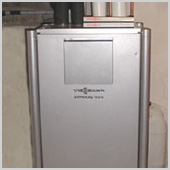
|
Heat Pumps
Overview
Using the compression of a gas, in a manner similar to a domestic refrigerator, heat can be
taken up at a low temperature (for example 10°C) and given off at a higher temperature (for
example 40°C). This process is driven by mechanical compressor systems (heat pumps). Heat
pumps have been around for several decades. The up-front investment has to be seen in the
light of the long life of these systems; around 20 years for heat pumps (using scroll pumps,
which are generally used today) and 70 years for the ground loop. This means that we
budget for a 20-year life for ground-source heat pump systems. The maintenance requirements
for these systems are minimal.
The large advantage of a heat pump system is that, with a coefficient of performance (the
ratio of heat output to work input) of 2.5-3.0, only around a third of the amount of
heat generated has to be supplied as primary energy (mainly for driving the compressor).
Particularly beneficial for the environmental balance is the use of internal combustion
engines for driving compressors directly instead of using electricity. This maximises the
overall efficiency of the system.
Examples of heat sources for heat pump systems are ground water, soil, outside air,
waste water or other liquids or gases which are available when heat is required.
The smaller
the temperature difference between the heat source and the delivered heat,
the more efficiently a heat pump operates. Heat pumps are, therefore, well suited
to heating buildings fitted with underfloor heating, which typically operates at a
much lower temperature than conventional radiators.
Ground-source heat pumps
|


